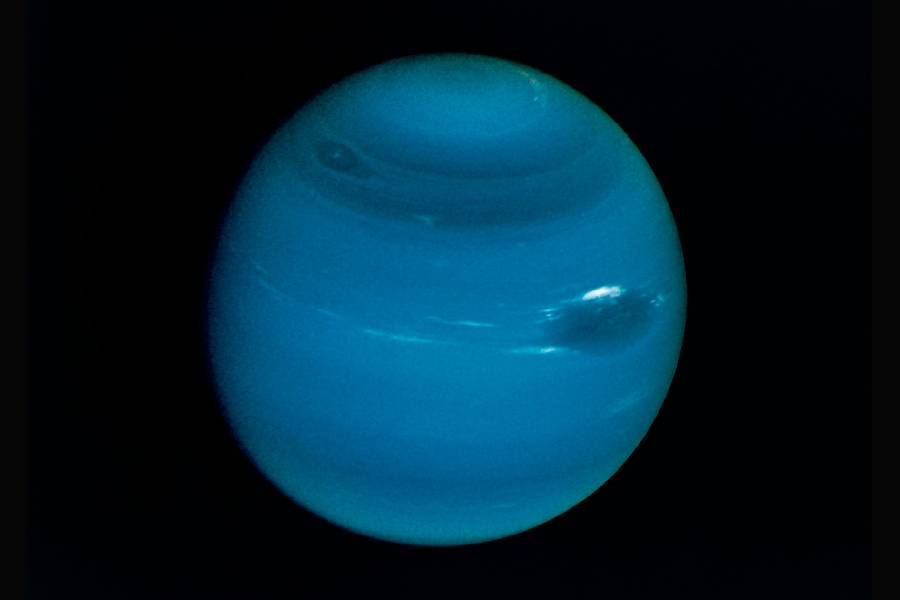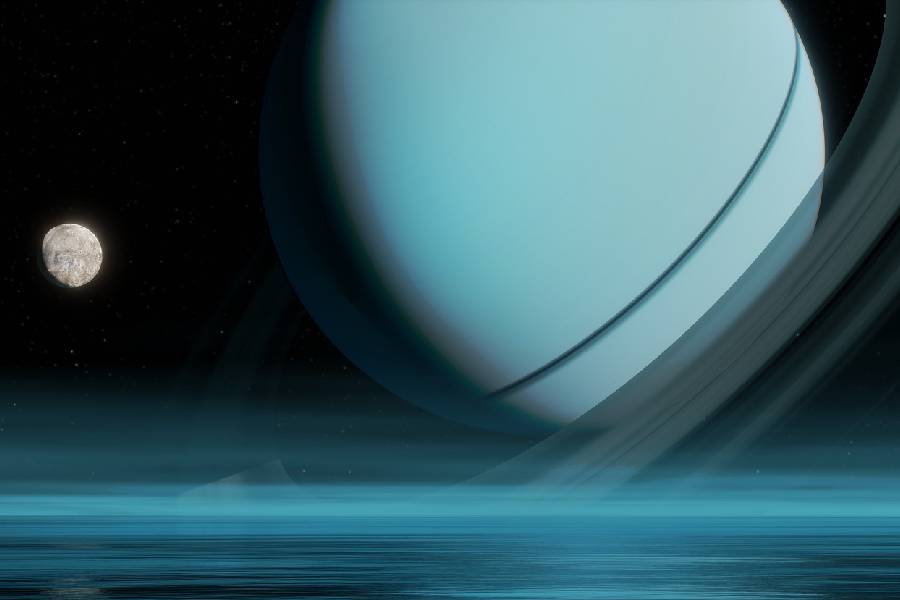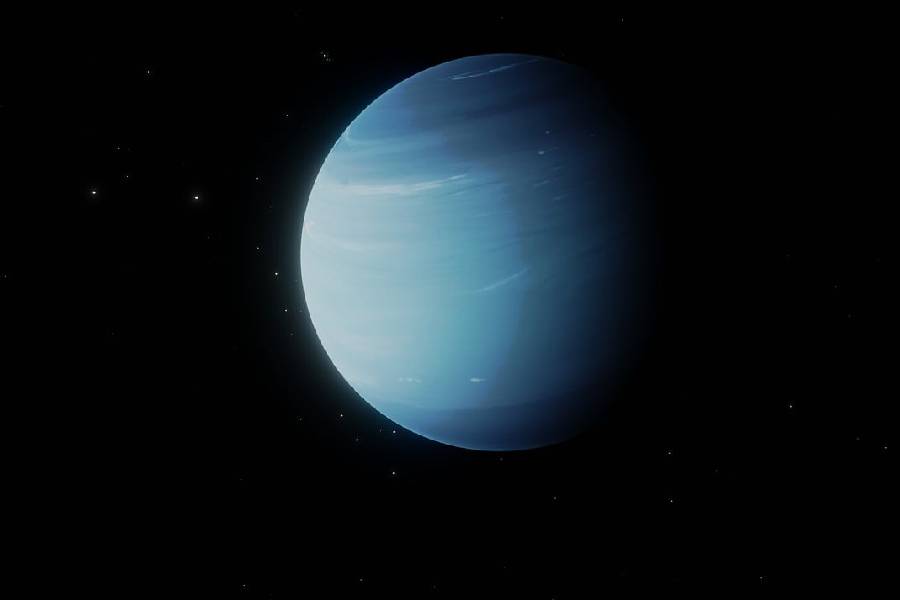The farthest planet from the Sun, Neptune, is an intriguing world that remains mysterious even after decades of study. Though discovered in 1846, many Neptune characteristics were discovered when NASA’s Voyager 2 spacecraft flew past in 1989.
Even now, Neptune holds secrets that continue to perplex astronomers. This distant sentinel watches over the dark boundary between our solar system and interstellar space. What fantastical discoveries remain hidden in its churning atmosphere and dynamic weather?
Neptune tantalizes with its subtle blue hue, storms that rage for years, and moons that crackle with activity. There is still much to uncover about this remote planet and its complex characteristics.
So, we will explore some of Neptune’s most fascinating mysteries, including its strange rotation, raging storms, frigid atmosphere, enigmatic moons, and more.
Neptune Characteristics
Neptune, the eighth planet in our solar system, is an ice giant with a rich tapestry of characteristics. It boasts a deep blue hue due to methane in its atmosphere and experiences extreme weather, including the fastest winds in the solar system.
Furthermore, Neptune has a complex ring system and a diverse family of moons, with Triton being its most prominent moon. Its enigmatic nature and distant location continue to captivate scientists and space enthusiasts.

Composition and Atmosphere
Neptune is an ice giant composed primarily of heavier volatile elements like water, ammonia, and methane. Unlike gas giants Jupiter and Saturn, which are predominantly hydrogen and helium, Neptune contains a much higher proportion of icy materials.
Neptune is estimated to be made of 30% rock and 70% ice, with trace gases surrounding the core. The inner core likely consists of iron and nickel-iron alloy, surrounded by layers of hot ice like water, ammonia, and methane. These ices form a thick mantle over the core.
Methane’s role in its striking blue color
One of the most striking features of Neptune is its deep, azure blue color. This is caused by the presence of methane in its outer atmosphere. Methane absorbs red light from the Sun, resulting in strong absorption bands at red and infrared wavelengths.
This absorption strips away the red end of the visible spectrum, causing the reflected light from Neptune’s atmosphere to appear predominantly blue. The methane gas responsible for this exists only in the upper cloud layers.
Atmosphere’s layers and extreme weather conditions
Neptune’s atmosphere consists of multiple layers of clouds at different temperatures and pressures. The uppermost layer is the tropopause, where temperatures reach -200 °C ( -328 °F). Below this are alternating cloud decks of methane ice crystals and ammonia ice crystals, as well as possible water clouds lower down.
Despite the cold temperatures, Neptune exhibits highly dynamic weather patterns, with winds up to 1500 mph, some of the fastest in the solar system. These are likely driven by convection from the planet’s internal heat. Massive storms, like the Great Dark Spot, have been observed, powered by this internal energy.
Weather Patterns
Neptune hosts some of the fastest winds in the solar system, reaching up to 1,500 mph speeds. These winds whip around the planet at velocities approaching supersonic. Powerful jet streams flow in east and west directions in the equatorial region.
Neptune’s winds are seasonal, strengthening and weakening over the planet’s long seasons. The mechanisms driving these extreme winds are not fully understood but likely involve convection and latent heat release.
Major storm systems
Some of the most dramatic weather features on Neptune are massive storm systems. The Great Dark Spot, first seen by Voyager 2, was an anticyclonic system likened to Jupiter’s Great Red Spot. Winds inside this storm swirled at up to 1,000 mph.
Great Dark Spot Jr. was a similar storm system observed later. A massive storm called the South Polar Vortex has been observed more recently. These storms seem fueled by internal heat from the planet’s core. Smaller storms called “scooters” have also been detected, rapidly moving across the planet.
Theories on the origins and behaviors
The extreme meteorology of Neptune remains somewhat mysterious. However, theories exist about the roots and patterns of its weather. Jupiter-like convection of internal heat may drive storms, while latent heat released from condensing methane may help fuel them.
Rotational effects likely shape the turbulence through Coriolis forces. Interactions between layers of different temperatures and compositions in the atmosphere also play a role. However, long-term observation is needed to better understand the origins and evolution of Neptune’s dynamic storms.
Rings of Neptune
Neptune has a complex system of rings composed of microscopic particles of dust and debris. The rings are likely remnants of collisions between moons or cometary debris capture.
Neptune’s main rings include the narrow Adams Ring, unusually variable density, and the broader, fainter LeVerrier and Lassell Rings. The rings contain several denser arcs of material, likely held in place by gravitational resonances with Neptune’s moons.
Ring composition and dynamic nature
The particles making up Neptune’s rings are composed primarily of ice coated with organic material. They range in size from large boulders to fine dust. The ring composition might be similar to the Uranian ring system.
Moreover, the arcs demonstrate dynamically changing densities and structures over time. Shepherding moons may shape these arcs through gravitational forces. Also, Neptune’s rings are thought to be relatively young and may represent an early stage of ring evolution.
Comparison to other ringed planets
Neptune’s rings share some similarities with those of Uranus, Jupiter, and Saturn. All contain dark, reddish material. However, Neptune’s rings are less substantial than many other major ring systems.
The dusty composition is more similar to Uranus’s system than the icy rings of Saturn. Neptune’s ring structure with denser, dynamically changing arcs is unique in the solar system so far observed. More discoveries about ring origins and evolution may come from further study.
Neptune’s Moon System
Neptune has 14 confirmed moons, each with unique traits. The inner moons are smaller and have irregular, chaotic orbits from repeated disruptive collisions. Larger regular moons like Triton, Nereid, and Proteus have more stable, prograde, circular orbits.
These moons are likely captured Kuiper Belt objects. Neptune’s moons provide insights into the planet’s gravity, magnetism, and formation history.
Analysis of Triton
Triton is by far Neptune’s largest moon at over 1,680 miles in diameter. It has a retrograde orbit and evidence of geologic activity.
Triton is one of the few moons with a substantial atmosphere. Nitrogen ice covers much of Triton’s surface with exotic landforms like ice volcanoes. It may have an internal ocean. Triton is thought to be a captured Kuiper Belt object and its orbit is slowly decaying toward Neptune.
Intriguing characteristics of other moons
Neptune’s other moons, like Nereid, exhibit chaotic rotation from frequent collisions. Proteus is dark and cratered with a shape-shifting, tidally-distorted body. Small, inner moons like Despina orbit just outside Neptune’s rings.
Furthermore, the more distant moon Halimede has a retrograde, inclined orbit. Each moon provides glimpses into Neptune’s origins and environment. Many mysteries remain about the formation and composition of these small worlds.
The Hubble Space Telescope and Neptune’s Observations
The Hubble Space Telescope has proven invaluable for studies of Neptune since its launch in 1990. Hubble’s high-resolution imaging and spectroscopy from above Earth’s atmosphere have allowed unprecedented observations of Neptune’s atmospheric features, weather patterns, ring dynamics, and moons.
Highlights of key observations and discoveries
The Hubble imaged the Great Dark Spot and provided insights into its unusual dynamics. It also discovered the Small Dark Spot storm and tracked rapidly moving “scooter” storm systems. Also, the Hubble spectroscopy revealed the composition of Neptune’s atmosphere and rings.
Moreover, it studied the periodic brightening of Neptune’s rings and discovered arc variations. Hubble also captured rich images and spectra of moons like Triton, observing surface changes, atmosphere composition, and exotic features like cryovolcanoes. These and other observations have vastly expanded knowledge of distant Neptune.

The Ongoing Mysteries
Despite past exploration of Neptune, many details remain elusive. For example, the complex interactions of heat flow, atmospheric composition, and rotation that drive Neptune’s extreme weather are still not fully understood.
The formation of features like arcs in the ring system is another mystery yet to be solved. Even basic characteristics like its tilted magnetic field and uneven internal structure perplex scientists.
Current and future missions
Our understanding continues to grow with advanced telescopes operating at various wavelengths. The James Webb Space Telescope might provide further infrared insights.
NASA also considers orbital missions to the ice giants like the proposed Trident probe. Meanwhile, ground-based telescopes gather crucial long-term observations of Neptune over its long seasonal cycle.
Potential for advancements
Up-close exploration could provide revelations about Neptune’s atmosphere, internal structure, magnetic fields, ring dynamics, and more.
With continued observation and ambitious new missions, our comprehension of this distant, cold, blue giant will likely grow in exciting new directions. Neptune still has myriad secrets left to be uncovered as exploration of the outer solar system continues.
Frequently Asked Questions
How do we describe Neptune?
Neptune is known as an “ice giant” planet. It is the 8th and farthest planet from the Sun in our solar system. Neptune is one of the bluest objects in the solar system due to its atmospheric composition.
It is a gas and ice giant, smaller than Uranus but larger than Earth, with a rocky core surrounded by ice and gas. Also, Neptune has extremely fast winds and large, turbulent storms in its atmosphere. It has a system of thin rings and many moons, including Triton. Neptune orbits the Sun once every 165 years.
What are the specific elements and compounds that make up Neptune’s unique blue color?
Small amounts of methane gas cause Neptune’s strikingly blue color in its outer atmosphere. Methane absorbs red light, leading to strong absorption bands in the red and infrared spectrum.
This absorption strips away the red end of the visible spectrum, causing Neptune to reflect predominantly blue light. Specifically, methane’s absorption at 619 nm, 687 nm, and 867 nm wavelengths results in this blue color.
What is special about Neptune as a planet?
Neptune has several unique traits that set it apart. It generates internal heat even though it is 30 times farther from the Sun than Earth. Neptune has extremely fast winds that can reach up to 1,500 mph. It has a surprisingly dynamic climate with large storms like the Great Dark Spot.
Neptune also has a tilted magnetic field and a backward-rotating magnetic pole. The orbits of some moons are tilted and irregular compared to other planets. Triton’s orbit suggests Neptune captured it.
Why does Neptune have such extreme weather patterns and storms?
There are a few factors that contribute to Neptune’s extreme meteorological activity. First, Neptune generates significant internal heat, even far from the Sun. This internal heat powers convection currents, which drive fast winds in its atmosphere.
Additionally, temperature differences between the cold cloud tops and warmer interiors create instability, fueling storms. Methane in the atmosphere condenses and helps release latent heat, energizing storm systems.
Rotational effects from Neptune’s sideways tilt also influence wind and weather patterns through Coriolis forces. So, the complex interplay between Neptune’s internal heat, atmosphere dynamics, and rotational effects results in some of the most extreme weather in the solar system.

Conclusion
Neptune remains an intriguing world of mysteries since its discovery over 175 years ago. This distant, cold planet tantalizes with its deep blue appearance, extreme winds, raging storms, and complex moons.
Neptune’s composition and atmosphere allow glimpses into the nature of ice giants. Its methane-rich upper atmosphere gives Neptune its signature color while driving dynamic weather patterns that are not yet fully understood.
Below the hazy blue clouds lies a thick mantle of hot ice surrounding a small rocky core. Neptune’s intricate ring system and collection of moons, dominated by the unusual Triton, offer more puzzles to solve.
Our observational capabilities will likely reveal more secrets about Neptune characteristics as we improve. Up-close exploration could uncover new revelations about icy planets.

